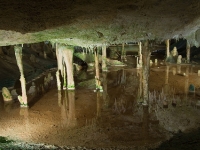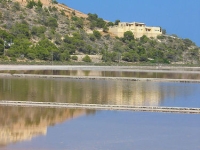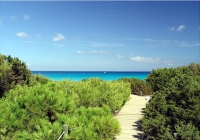Ibiza Travel Guide
For some, Ibiza is a hedonistic playground of stylish beach venues and thrilling nightclubs, where they can cut loose with a vengeance. Those in search of a retreat, however, can wander the jagged coastline or escape to the inland garden of ancient olive groves and fragrant pine forests. The idyllic island's many faces have something for everyone.
Ibiza's main town is the port of Ciudad de Ibiza, which locals know as Eivissa and visitors call Ibiza Town. Located in the south, it's the centre of the island's nightclub scene and has a lively marina and quaint old quarter, where there are some great restaurants. It lies close to the beautiful beaches of Figueretes, Es Cavallet, and Ses Salines.
San Antonio is the main resort town and is somewhat blighted by high-rise hotels and apartment blocks. The area is making efforts to clean up its slightly tarnished image, though, and its popularity is still legendary.
Clubs are the main attractions for many holidaymakers but there are also some beautiful coves nearby that have glorious beaches. It's best to get there early in the summer months to reserve a spot. Just three miles (5km) offshore is the 'satellite' island of Formentera. This little haven is reached by ferry and is less crowded, even at the height of the sweltering summer season.
There's good public transport between Ibiza Town and San Antonio, and to and from the main beaches and resorts. Taxis offer superb value and are the best way to get around in the evening, though the 'disco bus' that travels from San Antonio to the main clubs in Ibiza Town during the peak season is worth looking into. Cars and scooters can be hired by the day or week for those wanting to explore the island. Ferries run from San Antonio and Ibiza Town to nearby beaches between May and October.
Things to do in Ibiza
There is much more to Ibiza than its famous nightlife, and plenty to attract those with no interest in dancing and partying. The most obvious Ibiza attraction is the glorious coastline, which boasts many truly beautiful beaches along over 120 miles (200km) of coastline, and offers abundant scuba diving opportunities.
Ibiza has more than 80 beaches to choose from, including the popular Cala Jondal, S'Aigua Blanca, Cala Benirras, Cala Xarraca, Ses Salinas, Playa de Ses Figueretes, and Playa des Cavallet (Ibiza's official nudist beach). Water sports on offer apart from scuba diving, include waterskiing, sailing, windsurfing, kayaking, and much more. Many of the beaches are lined with bars and restaurants and have a festive, party atmosphere during the summer season.
Away from the beach, Ibiza's Old Town is lined with picturesque cobbled lanes leading to ancient courtyards with some buildings dating from the 10th century. Further up the coast is the charming village of Santa Eulalia, which has excellent beaches, and the nearby caves of Can Marca.
Another special natural feature of Ibiza is the salt flats, La Salinas, which are worth a visit. The Ibiza Express mini-train departs from Platja d´Es Canar along various routes, and is a fun way to explore the island.

Ibiza Old Town
The old medieval district of Ciudad de Ibiza (Ibiza Town), the capital of the island, sports narrow cobblestone streets, picturesque whitewashed houses and Gothic buildings around courtyards bright with blooming geraniums and bougainvillea. Ibiza'a Old Town is a UNESCO World Heritage Site, with architecture spanning 2,500 years of history. The Old Town, enclosed by historic walls, is best entered through the Puerta de las Tablas, which sees visitors passing across a drawbridge flanked by ancient statues; there is another entrance, Portal Nou, behind the Plaza del Parque, which is somewhat less dramatic. The district is best explored on foot, and contains some interesting sights, most noteworthy of which is the Archaeological Museum.

Cova de Can Marca
The tourist attraction cave complex of Cova de Can Marca sits a few miles north of Sant Miquel, a village with an attractive hilltop church and good tapas bars. The caves have been commercialised and fitted with some spectacular sound and lighting effects, providing for an entertaining guided tour. The caves are situated atop a rocky inlet, with spectacular views over the bay and of the islands Murada and Feriradura. The cave is said to be more than 100,000 years old and features underground lakes, stalactites, and stalagmites. There was once a natural waterfall in the cave system but the waterfall featured on the tour today is a replica, as the waterbeds of the cave system are now fossilised.

La Salinas
The salt flats of Las Salinas are some of Ibiza's most famous landmarks, and are close to the airport on the southernmost tip of the island. They've been used for more than 2,000 years since the Carthaginians traded with the salt left in the pans after the waters evaporated in summer.
The sparkling lakes provide one of the world's most beautiful sunset photograph opportunities. The fashionable Las Salinas beach on the southern tip of Ibiza attracts a glittering crowd of sun worshippers and party animals, including many celebrities, the wealthy, and the beautiful.
There are numerous beach bars to try out. The salt flats can be found in the nature reserve that surrounds this gorgeous beach, along with pine forests, sand dunes, and a general abundance of natural beauty.

Formentera
The tiny island of Formentera covers 35 square miles (90 sq km) and is home to just over 5,000 people. It can be reached by ferry from Ibiza Town, with a regular service running every two hours. Ferry services to Formentera from the mainland have also been established, due to the island's increasing popularity. It's relatively unspoilt by tourism development, although not as empty of crowds as it once was. Accommodation options are very limited. The main attractions are some pretty villages and marvellous beaches flanked by palms and pines, many frequented by nudists. The best way to explore is on a rented moped or bicycle, as well-maintained cycling tracks traverse the island.
Shopping
Ibiza has plenty of boutiques and unique stores catering to international visitors. During the high summer season (June to September) shops in the port are open until well after midnight. However, in the off season they may be closed entirely during the week. Leather goods abound in Ibiza, but quality is hard to come by. Ibiza also has some great markets to supplement the touristy shops found all over the island. The best and most famous is the Hippy Market at Club Punta Arabí, running from April to October. The Sant Jordi Car Boot market on Saturdays is also fun, as is the night market at Las Dalias in San Carlos. Vendors at the markets generally expect people to haggle over prices.
Nightlife
Ibiza's nightlife offers one of the best clubbing experiences in Europe through unrivalled mega-venues that feature the world's top DJs and countless cafés, pubs and bars. The main venues are clustered around San Antonio on the east coast of the island and Ibiza Town on the west, linked by a half-hour drive along a good road. There are very few nightlife venues on the rest of the island, which is quiet and rural.
An ideal foundation for a big night out is the place that gave birth to the Ibiza legend in the first place: Café del Mar in San Antonio. The trademark ambient music and chilled-out atmosphere is still in place, making this an essential visit. Innumerable other bars have sprung up around Café del Mar, so there's no shortage of vantage points to enjoy the justly famous sunsets. The top clubs open around midnight, with long queues forming by 2am.
Clubbing in Ibiza is certainly expensive. Entry fees get hefty and drinks are pricey. Many clubs will only have hot water available in the bathrooms to prevent visitors drinking cold water for free, forcing patrons to pay for bottled water. Cash-strapped young clubbers will hand out flyers and promos in the early evening with details of special offers, happy hours, and discounts. They are earning a commission for getting people through the door but the information can be very useful if visitors want to get maximum value for their night out.
As for getting around, visitors should use the disco buses that transport clubbers along the road linking San Antonio, San Rafael and Ibiza Town. Additionally, taxis are cheap, especially if visitors are travelling in a group.
The clubbing season runs from late May to September, although there are big parties around New Year's, Christmas, and Easter. Dress codes are non-existent. In fact, the more outlandish and extroverted a visitor's appearance, the better their chance of gaining free admission.
Getting Around
Renting a car is easy and popular on Ibiza, but in the summer months, between June and August, high demand for rental vehicles means that it's best to book in advance. Those hiring cars should note that between the notorious local drivers, drunken tourists, and poorly signposted roads, driving can be a hair-raising experience on the island and should only be attempted by confident drivers. Taxis and buses can be used to travel between towns and many resorts and tour operators provide transport for their guests. The towns and resorts of Ibiza are almost always small and best explored on foot.
Ibiza Climate and Weather
Ibiza has a typical Mediterranean climate with long, dry summers and mild winters. Between May and September the days are warm, with temperatures usually averaging comfortably between 69°F (21°C) and 82°F (28°C).
August is the hottest summer month, and there are lows of 71°F (22°C) and highs of 86°F (30°C). Ibiza empties out in winter, between December and February, but the island never gets really cold by European standards. The coldest month is January, when temperatures average between 46°F (8°C) and 59°F (15°C).
Ibiza doesn't get much rain and, even in the wettest months, the rain is sporadic and not overly disruptive. October is the wettest month, but rain is possible any time between September and April, leaving the summer months blessedly dry.
The Ibiza party season begins in late May and ends in September, making all the months in between extremely popular with young revellers. The peak summer months, between June and August, are the peak tourist season and considered by many to be the best time to visit. However, April, May and September, just outside of the most popular season, are also pleasant months to visit Ibiza, especially for those wanting to avoid the crowds.
Spain travel info
Electricity
The electrical current is 230 volts, 50Hz. European-style two-pin plugs are standard.
Language
Spanish is the official language, but English is widely understood in areas frequented by tourists. Catalan, Galician and Basque are spoken in the relevant areas.
Money
Spain's official currency is the euro (EUR), which is divided into 100 cents. Money can be exchanged at bureaux de change and major hotels, but banks give the best rates. All major credit cards are widely accepted at most hotels, restaurants, and shops. ATMs are widespread and are generally the cheapest and most convenient method of obtaining money.
Tipping
Hotel and restaurant bills usually include service charges, but additional tips are welcomed for services rendered. In established restaurants, tips of about 10 percent are expected. Drivers of metered taxis expect small tips and it's customary to tip about 5 to 10 percent for most services, including guides.
Health
There are no health risks associated with travel to Spain, and no vaccination certificates are required for entry. Medical facilities are good but comprehensive travel insurance is always advised. Spain has a reciprocal health agreement with most EU countries that provides emergency health care for EU travellers on the same terms as Spanish nationals. After Brexit, the Global Health Insurance Card (GHIC) replaced the European Health Insurance Card (EHIC) for UK citizens. The GHIC allows UK citizens access to state healthcare during visits to the EU. The GHIC is not valid in Norway, Iceland, Liechtenstein or Switzerland, nor is it an alternative to travel insurance. EU travellers should take a European Health Insurance Card (EHIC). Travellers should take any medication they require along with them, in its original packaging and accompanied by a signed and dated letter from a doctor detailing what it is and why it is needed.
Safety
Most visits to Spain are trouble-free except for occasional street crime. Petty crime, such as pickpocketing and purse snatching, is most common in larger cities, particularly during holidays, festivals and weekends, and especially on public transport and in tourist areas. Thieves may work alone or in groups; visitors should be wary of strangers who offer or ask for help of any kind, or inform them of a stain on their clothes, as these are often ways of providing a distraction for accomplices. There are also scams involving letters for outstanding traffic fines or Spanish lottery winnings. Travellers can avoid incidents if they exercise all the normal precautions.
Local customs
Smoking in public places is banned and stiff fines will be imposed for smoking in areas such as enclosed public spaces, areas where food is prepared and sold, public transport, non-smoking areas of bars and restaurants, and any places that cater for children. Drinking alcohol in the streets of Madrid and the streets of the Canary and Balearic Islands is illegal.
Doing business
The business culture in Spain is slowly shifting but, for now, it's entrenched in tradition and it can take some time for foreigners to gain a foothold in the Spanish working world. It's important never to undermine authority as hierarchy is central to Spain's business world. Managers tend to make decisions without considering input from their colleagues.
A strong emphasis is placed on social status, character attributes, and personal pride. Success is often hinged upon being well-dressed, honourable, and dignified, while also exhibiting great social skills. Business meetings are generally conducted face-to-face and can go on for long periods, as Spaniards prefer long deliberations in order to avoid uncertainty in corporate dealings. Business meetings in Spain tend to tread a fine line between personal and formal.
Conducting business in Spain can entail navigation through a lot of red tape and bureaucracy. Spanish is the language of business, but some of the larger multinationals conduct meetings in both English and Spanish. Business hours are often quite varied, but generally open by 9am and close in the mid-evening with a two-hour lunch break during the early afternoon.
Business attire is quite conservative with men wearing dark or linen suits, shirts and silk ties. Women should wear modest dresses or tailored suits. Brand names or labels attract affirmation from colleagues and associates.
After the conclusion of successful negotiations, gifts are appropriate. Gifts should be of high quality and, when receiving a gift, it should be opened in front of the giver. Business cards are important and should be bilingual. Meetings are best scheduled for mid-morning, and establishing a formal yet personable environment is important before beginning. Meetings often occur over lunches and dinners.
Duty free
Travellers from EU countries are allowed the following items duty free: 800 cigarettes or 400 cigarillos or 200 cigars or 1kg tobacco; 110 litres beer; 90 litres wine; and 10 litres spirit. Travellers from non-EU countries may have 200 cigarettes or 100 cigarillos or 50 cigars or 250g tobacco; 1 litre spirits, 4 litres wine, and 16 litres beer.
Communications
The international access code for Spain is +34. WiFi is widely available; travellers can purchase local SIM cards for unlocked phones or use eSIMs if their cellular providers support it on their networks.
Passport & Visa
The borderless region known as the Schengen area includes the following countries: Austria, Belgium, Czech Republic, Denmark, Estonia, Finland, France, Germany, Greece, Hungary, Iceland, Italy, Latvia, Lithuania, Luxembourg, Malta, The Netherlands, Norway, Poland, Portugal, Slovakia, Slovenia, Spain, and Sweden. All these countries issue a standard Schengen visa that has a multiple entry option, allowing the holder to travel freely within the borders of all. Non-EU nationals must hold a return or onward ticket, all necessary documents for onward travel and sufficient funds. It is highly recommended that passports have at least six months' validity remaining after the intended date of departure from Spain. Immigration officials often apply different rules to those stated by travel agents and official sources.
Entry requirements
United States citizens require a passport valid for three months beyond the period of intended stay. No visa is required for stays of up to 90 days within a 180 day period.
British citizens require a passport valid for three months beyond the period of intended stay. No visa is required for stays of up to 90 days within a 180 day period.
Canadian citizens require a passport valid for at least three months beyond period of intended stay. No visa is required for stays of up to 90 days within a 180 day period.
Australian citizens require a passport valid for at least three months beyond period of intended stay. No visa is required for stays of up to 90 days within a 180 day period.
South African citizens require a passport valid for at least three months beyond period of intended stay. A visa is required.
Irish nationals require a valid passport, but a visa is not necessary.
New Zealand citizens require a passport valid for at least three months beyond period of intended stay. No visa is required for stays of up to 90 days within a 180 day period.
Useful contacts
Spanish Tourist Office, Madrid: www.spain.info.
112 (General).


